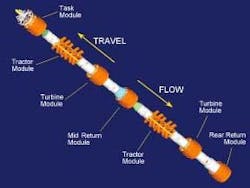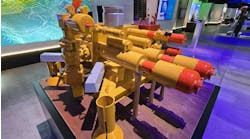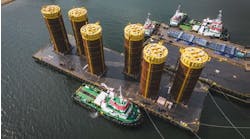While a large proportion of new and many older pipelines are conventionally piggable, for a significant number of lines, out of necessity or for financial reasons, this is not the case. To pig these lines or conduct in-line operations, operators are faced with the expense of installing special facilities, using dive support vessels (for subsea lines), undertaking major logistical exercises, and dealing with disrupted production. Sometimes the most economic option is to abandon the line.
For these unpiggable pipelines, a tool that could enter the line at a downstream location, travel against the fluid flow (to the wellhead, if necessary), and perform tasks as it travels would be advantageous.
The Contrapede tool:
- Operates in a pipeline without a tether and generates its own power from the fluid flow while travelling against the direction of flow
- Carries a payload to perform a specific task and returns with the flow, on demand or on encountering an impassable obstruction, to the launch site with no deferment to production
- Is of a modular construction for ease of modification to suit individual applications
- Is articulated for better negotiation of bends, and travels at a speed suitable to the individual application.
In 1998 Shell challenged three companies to demonstrate the operation of autonomous contraflow pipeline tool designs under a range of operating conditions. While all three tools met the challenge, Shell selected the Astec Developments Ltd. of Aberdeen design, for ongoing development support. Shell chose the Astec tool based on an existing coiled tubing tractor that had undergone extensive testing.
Weatherford International Ltd. acquired Astec in 2000. With funding from both Shell and Weatherford, Astec has continued development of the technology, resulting in a 6-in.-diameter demonstrator tool that the company successfully tested. Astec carried out trials in water-filled and oil-filled test loops, using single- and multi-phase fluid flows.
Each turbine module extracts power from the line fluid and transmits it to a central shaft in the traction modules through a reduction gearbox and articulated joint. This shaft carries a series of leg sets on offset cranks. As the shaft rotates, the leg sets oscillate (forward, outward, backward, and inward) to produce a walking action, allowing the tool to progress along the pipeline.
Astec tailored one or more task modules to specific applications. The modules can be powered directly by a turbine, by electric or hydraulic power, or by stored power sources.
On activation of the return module, the tool returns with the fluid flow to the launch site as a conventional pig would. In addition to on-board trigger mechanisms to ensure tool and pipeline protection, a range of external triggers – such as mechanical contact, pressure, temperature, sonic or magnetic sensors, and time-based triggers – can activate the return mechanism.
The Contrapede tool can access areas thought to be inaccessible and to solve problems previously considered economically unfeasible. Potential applications cover a wide range of tool tasks in many types of pipeline fluids, including:
- Deploying inspection tools, such as MFL, ultrasonic, and caliper tools
- Removing of pipeline debris, such as wax, scale, and asphaltines
- Sampling product or line contents (for example, water at a low point)
- Placing and recovering inline monitoring equipment.
Because it can be launched from and returned to the same downstream location, the Contrapede tool eliminates the need for a subsurface launch facility or dive support vessel in subsea applications and removes limitations imposed by weather and water depth. The tool can also be used in pipelines that have a low differential pressure.
The range of the tool is not limited, as it is with other tools, by the length of a tether (for example, wireline power cable or coiled tubing). Neither is the duration of the tool-run limited by an onboard power source, as it generates its own power from the fluid flow. No ongoing support during operation is required, and production is not deferred during tool operation, as the Contrapede tool actually requires line fluid flow to function. Because a dual flowline loop is not required, the tool can be operated in a single flowline. No specific launch facilities are required, as the tool can be launched from a standard pig launcher/receiver, if available, or from an isolated section of pipe through which flow can be directed.
This technology allows new cost savings options in future pipeline infrastructure designs and potential savings in the development of deepwater new-build projects. For several reasons the Contrapede technology can achieve capex and opex savings over current systems for conventional pigging.
- There is no requirement for twin pipeline loop systems
- No subsea launch facilities are required on single lines
- No subsea intervention is necessary during tool operation.
Development into a wide range of possible functions of the Contrapede tool and resizing options is ongoing. Future iterations could have the ability to walk both forward and backward in a controlled manner and operate in multi-diameter pipelines. The tool was developed initially for application in the offshore petroleum industry; however, it could be used in onshore applications, in water pipelines, and other process or flow industries, in both liquid and gas pipelines.




